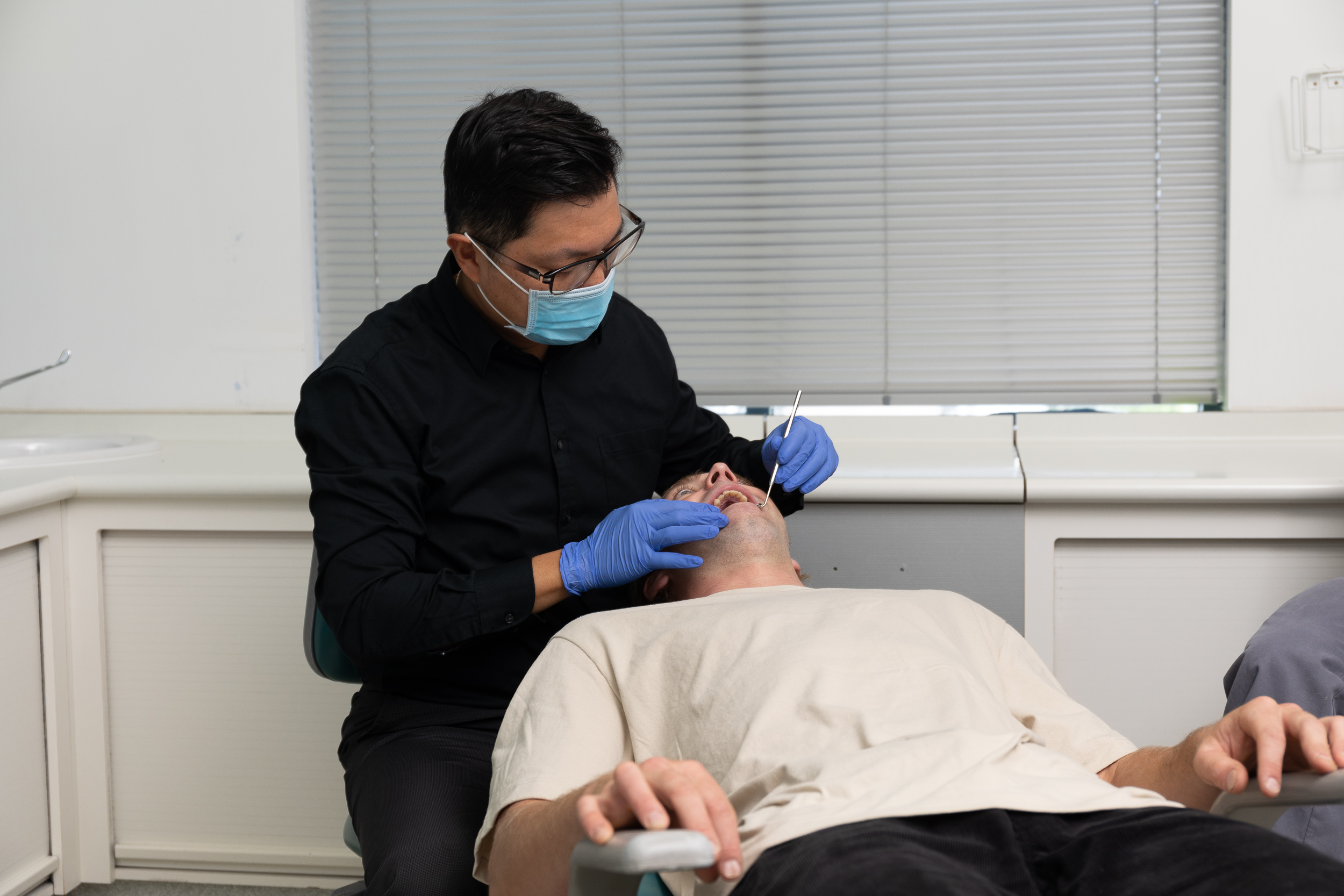
Underbite: Causes, Health Risks, and Treatment
Various conditions and abnormalities can affect our teeth’ overall health and appearance. One such condition is underbite, which occurs when the lower jaw extends further than the upper jaw, creating a misaligned bite.
Correcting an underbite is not merely a matter of enhancing one’s facial aesthetics but is crucial for maintaining oral functionality and overall health. An untreated underbite can lead to difficulties in chewing and speaking, which can impair one’s quality of life.
What Is an Underbite?
An underbite is a condition where lower teeth protrude beyond the upper front teeth, causing the lower jaw to jut out farther than the upper jaw. This misalignment is also known as a Class III malocclusion or prognathism. To better understand how an underbite differs from other dental misalignments, let’s compare it to an overbite:
- Overbite (Class II malocclusion): In an overbite, the upper teeth extend beyond the lower teeth, causing the upper jaw to protrude forward. It is the opposite of an underbite and is usually not as serious as an underbite in terms of potential health issues.
- Underbite (Class III malocclusion): An underbite causes the lower jaw to protrude forward. It can lead to problems with chewing, digestion, and speech, as well as potential dental problems like tooth decay and gum disease.
Causes of Underbite
Genetic, skeletal, and environmental factors can cause underbites. Some of the key factors contributing to the development of underbites include:
Genetic Factors
- Genetic predisposition: Underbite causes include genetic predisposition, with some genetic phenotypes being responsible for underbites throughout generations.
- Genetic syndromes: In some cases, malocclusions with severe skeletal discrepancies might be accompanied by genetic syndromes, which can influence the development of craniofacial complex.
- Family history: If one of your parents or grandparents had an underbite, there is a higher chance that you will also develop one.
Skeletal Factors
- Skeletal deformities: Class III skeletal deformities have been attributed to genetic and environmental aetiologies.
- Soft tissue influences: Lip incompetence and lower lip closure may significantly influence occlusion.
Environmental Factors
- Childhood habits: Certain habits during childhood, like thumb sucking, using pacifiers after three years old, and bottle feeding after infancy, may increase the chances of developing an underbite later in life.
- Tongue thrusting: This can be a contributing factor to the development of underbites.
- Environmental pressure: The shape and size of the upper and lower jaws may be determined more by environmental pressure for some patients. In contrast, it may be more under genetic control for others.
Types of Underbites

Underbites can be classified into three categories based on severity and origin – slight, mild, and severe.
Slight Underbite
A slight underbite occurs when the lower jaw overlaps the upper jaw. This type of underbite is not noticeable from the outside and does not affect the bite’s function.
Mild Underbite
A mild underbite is where the lower front teeth are slightly in front of the upper front teeth but doesn’t affect the bite’s function. Even if the underbite is mild, it is still classified as a Class 3 malocclusion.
Treatment options for a mild underbite include braces, clear aligners, or surgery in severe cases.
Severe Underbite
A severe underbite occurs when the lower jaw shifts so far forward that, the lower front teeth almost completely overlap the front of the upper teeth. People with severe underbite may have difficulty with eating, drinking, digestion, and talking.
Treatment options for a severe underbite vary according to the severity, which includes braces, clear aligners, or surgery. Jaw surgery is often required for moderate to severe underbites.
Signs and Symptoms of Underbite

Common signs and symptoms of underbites include:
- Difficulty chewing or speaking
- Jaw pain
- Tooth decay and gum disease due to teeth misalignment
- Chronic bad breath (halitosis)
- Temporomandibular Joint Disorder (TMD)
- Heavy snoring and mouth breathing
Early detection of underbites can lead to more effective treatment. Identifying and addressing underbites in children is crucial to ensure proper dental health and avoid more severe issues in adulthood.
Health Risks of Having an Underbite
It is important to address underbites to maintain overall oral health. Untreated underbites can lead to various consequences, including jaw pain and dental issues such as tooth decay and gum disease.
Misaligned teeth in underbite conditions can create hard-to-reach places, increasing the risk of infection due to hidden bacteria. It emphasises the importance of proper oral hygiene, including regular brushing and flossing.
Underbites can cause wear and tear on the front teeth, making them more prone to chipping or breakage. They can lead to difficulties in speaking and chewing food and conditions like temporomandibular joint disorder (TMD) that can influence how a person sleeps.
How is Underbite Diagnosed?
Diagnosing an underbite begins with a comprehensive dental examination. Dental professionals examine not only your teeth but also the alignment of your jaw to identify any abnormalities.
This assessment might involve a visual inspection and palpation of the upper and lower jaw. Dentists may also utilise imaging technologies such as X-rays, CT scans, or 3D imaging to better understand your condition.
These tools can reveal the structure and positioning of your jaw and teeth, providing crucial information for diagnosis and treatment planning. Seek a professional evaluation if you suspect an underbite, as early detection can prevent complications and make treatment more effective.
Underbite Treatment Options
Treating underbite involves various methods, including orthodontic solutions and surgical interventions. Dental treatments depend on the severity of the underbite and the individual’s unique case.
Braces

Braces are the most common way to align the bite, whether metal, clear, or lingual. They gradually move the teeth into the desired position and align the lower jaw with the upper one.
The benefits of braces include their proven effectiveness and the ability to address other dental issues simultaneously. However, they may be uncomfortable to wear, require regular adjustments, and take a relatively long time.
Clear Aligners
Clear aligners are another option for treating mild cases of underbite by straightening and realigning the teeth. They are removable and virtually invisible, making them popular for adults. However, they may not be as effective as braces for severe cases of underbite.
Palate Expander
Palate expanders widen the upper jaw and create more space for teeth, which can assist teeth alignment. They are often used with braces or clear aligners and are most effective in children and teenagers whose jaws are still developing. However, it can be uncomfortable and may affect speech and eating.
Surgery

Surgery is the suggested solution for severe cases of underbite in adults. Orthognathic surgery involves repositioning the jaw bones and helping realign the upper and lower teeth and jaws to improve their appearance and function. Corrective jaw surgery can provide a permanent solution, but it carries the risks associated with any surgical procedure and requires a significant recovery.
Orthodontic Face mask
An orthodontic face mask, or reverse-pull headgear, is used to correct underbites by pulling the upper jaw forward and the lower jaw backwards. It should be worn for at least 12 hours daily to be effective, which might be inconvenient or uncomfortable. It is most effective in children and teenagers whose jaws are still developing.
Early Intervention in Children
Early intervention in underbites is important for children. According to the American Association of Orthodontists, children should have their first orthodontic examination around seven years old. At this age, the orthodontist can take a special x-ray called a cephalogram to determine the cause of the underbite. An underbite can cause gum recession and other oral health problems if left untreated.
Parents should seek professional advice if they notice abnormalities in their child’s bite. Early orthodontic treatment prevents severe problems from developing and may be shorter and less complicated than treatment in later years.
Underbite FAQs
At what age should underbite treatment start?
The American Association of Orthodontists recommends that young patients with underbites should see an orthodontist by age 7 to determine if early treatment is necessary. This early intervention can help correct the growth of the jaw and certain bite problems, such as an underbite, and make room when permanent teeth begin, lessening the chance of extractions in the future.
Is underbite treatment painful?
The discomfort associated with underbite treatment can vary depending on the orthodontic treatment method used. For example, some children may experience pressure and minor discomfort when using appliances such as expanders or face masks.
However, the pain level is generally manageable, and the long-term benefits of correcting the underbite outweigh the temporary discomfort.
How long does it take to correct an underbite?
The duration of underbite correction can vary based on the severity of the underbite and the chosen treatment method. Treatment for underbite correction can range from 6 months to a year, and in some cases, it may take longer, especially if the underbite is severe.
The patient’s compliance and the growth of the jaw can also influence the duration of the treatment.
Can underbite lead to speech difficulties?
Yes, an underbite can lead to speech difficulties. It can affect how certain sounds are produced, leading to speech impediments.
Do underbites get worse with age?
Underbites can worsen with age, especially if left untreated. The jawline can be passed down through generations, and excessive and constant pressure on the lower teeth can worsen an underbite.
Conclusion
Underbites are a common dental condition that can cause aesthetic and functional concerns. Seeking professional evaluation is crucial as early detection can prevent complications and make treatment more effective.
A healthier and more confident smile is within reach with proper treatment and care!
So don’t delay; take the first step towards correcting your underbite today with Smile Team’s orthodontic treatment options.
Our experienced orthodontists will work with you to find the best solution for your unique case and guide you towards achieving perfectly aligned teeth.
Don’t let an underbite hold you back any longer; contact Smile Team today!